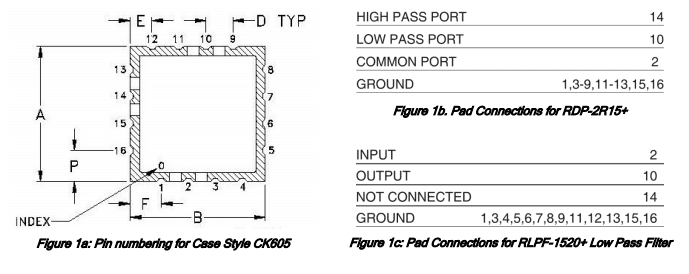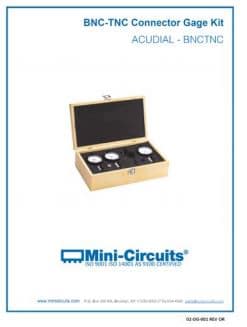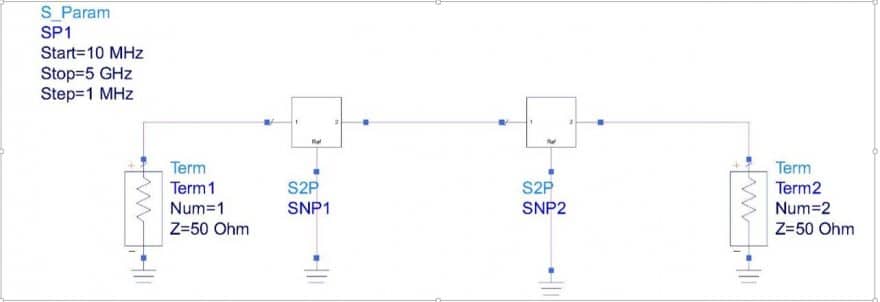Frequently Asked Questions About Power Detectors

Frequently Asked Questions About Power Detectors
Q. I recently purchased a PWR-6G power detector and was wondering if I need to have it calibrated, or if it came to me calibrated.
A. The PWR-6G+ is calibrated prior to shipping and therefore there is no need for calibration of new power detectors. A customer can start working once the power sensor software has loaded and the USB cable is plugged in to the computer. We recommend sending the PWR-6G+ once a year for calibration.
Ultra-Wideband, Low-Loss Couplers for Cable TV and Broadband Access Systems (DOCSIS® 3.1)

This article discusses the use of ultra-low loss, broadband distributed couplers in 75Ω systems such as broadband services over cable television networks (CATV).
Demystifying Pin-Outs: What Do We Mean by “Not Connected?”

Mini-Circuits offers a wide range of products in miniature surface-mount (SMT) packages. Each package is identified by a case style number and defined by a case style drawing which clearly shows the outline dimensions, critical dimensions (if any), orientation, pin numbering, pin-out details, and material finish wherever applicable.
Some case styles are used in various Mini-Circuits products, and different signal pads may be used depending on the circuit design of each model. In some cases, some signal pads on the unit may be left unused and marked as “NOT CONNECTED” in the pin-out details on the datasheet.
This article explains by way of example what we mean when we denote signal pads this way, and how users may treat these pads when mounting the part on their board.
MMIC Amplifiers Stretch the Boundaries of Dynamic Range in VHF/UHF Communications

The noise figure and linearity of low noise amplifiers are critical factors in maximizing sensitivity and dynamic range in RF receiver design. The amplifier noise figure determines the weakest signal the amplifier can discern, and the IP3 determines the degree to which intermodulation products from nearby signals interfere with the desired signal. The lower the noise figure and the higher the IP3 of the amplifier at the receiver input, the greater the sensitivity and Spurious Free Dynamic Range (SFDR) of the receiver.
Understanding Surface-Mount

The main reason for the utilization of surface mount technology today is for PWB area efficiency and the corresponding reduction of the system volume. Small surface mount components are used to manufacture electronic assemblies that are significantly smaller than the similar function assemblies using thru-hole components. Usually, the board area for most systems can be reduced by a factor of two for a single sided board. When components are mounted on both sides of the board, size reduction by another factor of two can be achieved. Conversely, the functional density can be doubled in the same area with the use of surface mount components. Since the height of surface mount components are generally smaller, significant reduction in system volume can also be achieved. Fewer, denser assemblies and correspondingly fewer connectors, less mechanical hardware and shorter lead lengths can yield another reduction factor of 2 to 4. Add to that the use of Application Specific IC’s (ASIC’s), and a total volume amounting to approximately 20% of the original system can result.
Interface Dimension Measuring Gauge

Mini Circuits manufactures a comprehensive line of connector gauges for measuring the critical interface dimensions of coaxial connectors .Testing the interfaces of connectors on any device at incoming inspection is not only highly recommended, it is definitely a necessity. Interfaces not meeting the specifications will lead to degraded specification of the components. In addition, these out of specification interfaces may damage the connectors of mating components or ruin the connectors of the test equipment. These connector gauges consist of an exclusively developed dial indicator with appropriate bushings and pins, designed to mate with the specific connector under test. The indicator is set to zero by a calibration block (master).When engaged to a connector, it measures the specific interface dimension from a reference plane.
Accelerating RF Component Selection with Yoni2® Advanced Search Engine for RF Components
Selecting RF components for a system design can be one of the more time-consuming tasks in the development cycle. To begin with, a designer may have to sift through hundreds of possible options for a suitable model. Each model represents a matrix of features and parameters with varying degrees of form, fit, and function compatibility with the design requirements. Evaluating the options may take hours or even days, and once a suitable part is identified, there’s still an element of uncertainty as to whether another model may have achieved better system performance. It’s the proverbial needle-in-a-stack-of-needles problem.
Hi-Rel Components for Space Applications

The extreme operating conditions of the space environment combined with lack of access for repairs and zero tolerance for failure necessitate intensive qualification of electronic parts used in space missions. Mini-Circuits has a successful track record of screening components for space applications, and our experience in this area has led to robust testing and qualification programs for the parts we supply for these systems.
ADVANTAGES OF CASCADING REFLECTIONLESS FILTERS

The insertion loss curves for the conventional filter exhibit an expected increase in stopband rejection when two filters are cascaded in series. However, obvious ripple appears across the stopband in the two-section curve. This is due to the unstable phase relationship between the through-signal and reflected signal. Additionally, unwanted ripple is present in the passband close to the band edge of the two-section curve. This is a result of return loss degradation in the passband and reflections in the transition. By contrast, the insertion loss performance for the reflectionless filter repeats itself nicely when cascaded in 2 and 3 sections without any of the ripples or distortion seen in the case of the conventional filter.
Figures 5e through 5h show the effect on return loss when the two types of filters are cascaded in multiple sections. The conventional filter exhibits significant degradation in input and output return loss in the passband when cascaded in two sections – by as much as nearly 20 dB in some regions. When the reflectionless filter is cascaded in two sections, on the other hand, input and output return loss varies over the passband, but the same degradation is not evident, and return loss actually increases at some frequencies relative to that of a single filter. This illustrates that an improvement in return loss in the passband and the stopband can be realized by cascading reflectionless filters versus conventional filters.
Selecting High Linearity MMIC Amplifiers for use with Complex Digital Waveforms

Enhanced Mode GaAs PHEMT (E-PHEMT) based MMIC amplifiers provide users advantages in both broadband noise figure and intermodulation performance, setting them apart from previous generations of GaAs amplifier designs. Historically known for their extremely low noise figure, PHEMTs have also been used extensively for power applications in the mobile PA market. Recent designs possess a combination of low noise and excellent suppression of intermodulation distortion, which improves both ends of the dynamic range over broad frequency range.





